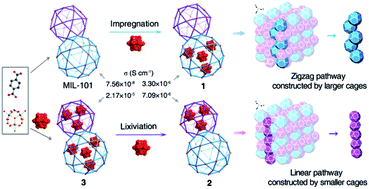Controllable proton-conducting pathways via situating polyoxometalates in targeting pores of a metal–organic framework†
Abstract
Proton conductivity is traditionally affected by proton concentration, mobility, hopping sites, etc. in metal–organic frameworks (MOFs). The influence of the profile of proton-conducting pathway has not been demonstrated due to lack of a suitable model. MIL-101 contains two types of tunnels with zigzag and linear profiles constructed by cages with different sizes. However, it is hard to construct an exclusive proton-conducting pathway with only one profile in MIL-101 because the introduced carriers usually locate without targeting a specific location. Keggin-type H3PW12O40 (HPW) has a unique nano size, which is between the window sizes of the cages in MIL-101, strong acidity, good stability, and abundant proton-hopping sites. Herein, two types of hydrogen bond networks were constructed by situating HPWs in the targeting pores of MIL-101. Linear pathways provide about 2.1-fold faster proton diffusion rates compared to zigzag pathways. Further modification of an HPW-impregnated MIL-101 with flexible polyamine resulted in a conductivity of 1.52 × 10−2 S cm−1.



 Please wait while we load your content...
Please wait while we load your content...